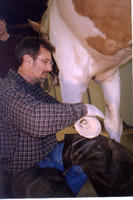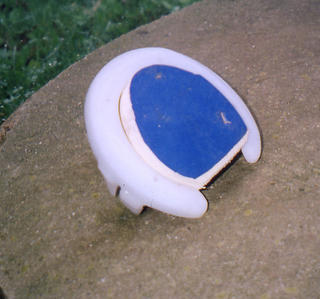 |
Paul Goodness glueing a shoe on
a demonstration horse in New Hampshire. |
I went to a seminar with one of my favorite farrier experts, Paul Goodness, last week. Paul is certainly a product of 20th century farriery. With a 20-year career at the top of the international sport-horse world behind him, he's now neck-deep in a nine-farrier practice that offers what is probably one of the best apprenticeships available anywhere in the world. Even vets go there for informal internships.
Paul did a great demo at New Hampshire's Rochester Equine Clinic of what he calls "sole-glueing" (also called direct-glueing) and then mixed a post-surgery toe extension for an flex-deformity foal from Spectra fibers and Equi-Bond, etc. No nails in sight at that seminar. Paul says that the farriers in his practice glue more than half of the horses that come through his shop.
He had an interesting demo shoe that was a Mustad Easy-Glu with a very thick compressible pad. It looked so comfy, I wanted a chunk of it to put inside my boots. I asked Paul what it was, and he said he had found a wrestling mat in a dumpster and discovered that the compression and cushion worked just right for a foundered horse...
 |
| A Mustad glue-on shoe with a wrestling mat insert. |
Another found-object farriery fix from Paul was the sticky back foam tape used to seal truck caps onto beds (and lots of other uses, especially if you have a boat). Paul cut it to fit the toe of a Natural Balance shoe, and in another instance, a heel. Sort of a quick rim pad with a slight cushion, but you can cut it to fit whatever part of the shoe (or, rather, the foot) needs it.
A surprising story from Paul: He needed to alter a shoe for a lame horse so he was looking for a creaser, in preparation for punching a hole for a heel nail. He couldn't find a creaser anywhere on his tool table. He asked two of the first-year apprentices if they had taken his creaser. "What's that?" they asked.
 |
| Cushioned shoes instead of rim pads use foam tape |
Paul has a unique approach with his apprentices. He looks for young people who are experienced in working with horses and often recruits grooms. Their training starts with the horse, and progresses to understanding the foot. "I can teach people forging later in their training," Paul told us. "But I can't teach someone to have a "feel" for working around horses. You have to be good with horses and get into the foot. That's where I start them. Forging skills can wait. I can teach that to anybody."
--Story and photos by Fran Jurga


